Recording Wynton Marsalis and Vitoria Suite: A Jazz Journey from Basque Country to Manhattan Valley
HARLEM, MANHATTAN: Who are the lighthouse keepers for New York City’s brilliant musical beacon? The giant of jazz known as Wynton Marsalis surely stands as one such sentry, an adventurist and nine-time GRAMMY winner radiating original sound experiences from our musical epicenter out to the world.
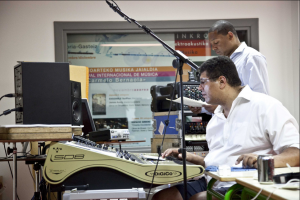
Jeff Jones (seated) and Wynton Marsalis were on a musical mission with the making of "Vitoria Suite" (photo credit: JoanneLeveyPhotography.com)
The master capped off 2010 with the release of Vitoria Suite, an epic 12-part sound voyage recorded over three days in June, 2009 with the Jazz at Lincoln Center Orchestra and a world-class roster of guests — including virtuoso flamenco guitarist Paco de Lucía — at the Jesus Gundi Conservatory in Vitoria, Spain. A tribute to the city and its storied jazz festival headed by Inaki Anua, Vitoria Suite is a nonstop sonic odyssey – from its fiery takeoff to the dizzying climax, the opener “Mvt. I: Big 12” takes listeners to such a breathtaking place, one can only imagine what lies ahead.
Richness and musical dimensions of every color, shape and size define Vitoria Suite, a record that represents a true journey for the listener, musicians, and – naturally – its impassioned producer/engineer/mixer/editor. The latter is Jeff Jones (thejedimaster@mac.com), the self-proclaimed “Jedi Master” whose versatile discography includes Public Enemy, Talking Heads, Slick Rick, Willie Nelson, Norah Jones and scores more. The Jedi Master takes recording very, very seriously, as we shall soon see.
Motivated to match and build on the legendary recording contributions of Rudy Van Gelder, the Harlem-based Jones watched over every detail of Marsalis’ years-in-the-writing masterpiece, while allowing its warmth and excitement of discovery to come shining through. For Vitoria Suite’s mind-blowing meld of jazz, blues, Basque music, and flamenco, our talk with Jones confirmed that nothing less than an obsession with perfection would do.
You’ve said that you want to be the “Rudy Van Gelder of tomorrow”. That’s a bold statement. What do you mean by that?
I have been studying records and record-making — and film-making — since I was a kid. I always checked out articles, books, documentaries…anything I could get my hands on. When mixing I explore each style of music, learn its stylistic center and way of being recorded. Since I’ve been studying, apprenticing under Wynton Marsalis and veteran producer Todd Barkan I’ve gotten a deeper understanding about the center of jazz music.
If you study jazz, you have to study Rudy. He developed his own unique sound partly by taking control of the process from recording through mastering at a time when very few people did that sort of thing. He built his own studio and bought a lathe to cut masters. As a result his sonic vision was consistent because he did everything himself. I’ve taken on wearing all the hats now from recording through mastering. You have to do that to make the artistic vision consistent.
Dr. John called me the next Tom Dowd — both Tom and Rudy were inventors. You have to be a bit of a scientist to come up with new stuff when melding such deeply complex worlds as music and recording technology. Those two guy just did so many records that are now considered classics: It’s impossible to be a music listener and not hear their work. Their records have stood up to the test of time. That’s the kind of records I make also.
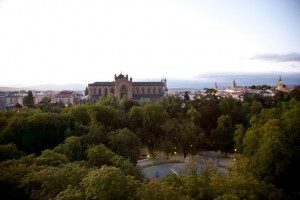
Vitoria: The heart of Basque Country and a source of inspiration for Wynton Marsalis (photo credit: JoanneLeveyPhotography.com)
Nothing half-way about that philosophy! So how do you go about actually accomplishing your approach, in actually practice?
I’m looking to bridge the core elements of historic recordings with new techniques, used with today’s technology to make something new and unique.
Doing something that’s never been done before is really, really difficult. It requires a lot of shedding and a lot of thought. The questions I ask myself are, “Conceptually how do I bridge the gap from the old to the new? What was the old? What equipment? How was that equipment used then? Who manufactured that equipment and how was it built? What were the limitations? And how did they work around them? What were the mediums used? How do they differ from the mediums used today? What are the strengths and weaknesses of yesterday’s mediums and the same for today’s? In total how do I make something new with today’s tools, that is grounded in the history of all recorded mediums that existed before now?”
With such deep musical thinking, it’s little wonder that you and Wynton Marsalis would eventually work together. How did you and Wynton first meet, and what made you really connect as artist/producer?
I first met Wynton when I recorded him at a small Lower East Side benefit concert at the House of Tribes. I was asked to make the recording by the producers of the concert — I suggested we also bring video cameras. I had seen a short amateur clip from the previous year’s concert, and I knew the music would be outstanding.
I made an eight track recording and asked my friend Chuck Fishbein to bring his cameras. After the concert I spent the next five months editing, color-correcting, mixing and mastering to make an hour-long pilot which I hoped at the time would eventually become a television show. The audio from that recording was released on Blue Note and nominated for a GRAMMY and the video played on BET Jazz — you can find clips from that original concert on YouTube.
I think Wynton Marsalis and I pair well because we’re both all about making history and classic purists. He demands excellence from anyone that he works with, and he totally respects the art. My background has both classical and jazz in it — that also makes us a good match.
Fast forward to Vitoria Suite — the origins of this project are pretty interesting…
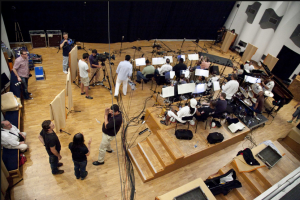
The JLCO had room to maneuver in the Jesus Gundi Conservatory. (photo credit: JoanneLeveyPhotography.com)
The head of the Vitoria Jazz Festival asked Wynton to write a piece of music for him, and Wynton ended up writing a twelve-movement piece that took him 10 years to complete. Wynton started the project long before I met him. The recording, editing and mixing process took a full year to complete.
Vitoria Suite was recorded in a music Conservatory theater in northern Spain. The Pro Tools recording equipment package came out of Madrid — I knew that we couldn’t record at 96/24 because the equipment supplier didn’t have enough AES inputs, so the master session was recorded at 48 kHz/24-bit.
My basic approach was to ultra mic everything. The reed players alternately picked up flutes and clarinets so they had double mics top and bottom. In some movements there was extra percussion and a flamenco dancer, plus the arrangement called for the band to add handclaps. I figured I would pick through the mics and use the best combinations in the mix.
Before the recording sessions I saw portions of this twelve-movement piece performed at a jazz festival in Canada, I realized there was no way to separate any of the band members acoustically. Wynton usually records without using headphones anyway, so I set up the risers on the stage to facilitate the normal live setup of the band. It’s a challenge to record so many instruments in an acoustically live room. I recorded 50 channels of individual microphones plus a live stereo reference mix simultaneously.
Why do a live mix? That seems like a stresfful undertaking on top of an already huge undertaking.
I like the energy of a live mix — it’s a kind of Holy Grail that you never get back at any other point during a project. The live mix serves as a template for doing the massive amount of editing needed on Wynton’s projects. I do all my editing on the two-track before editing the multitrack, and each of the 12 movements in Vitoria has at least 15 edits across a 50-track multitrack. There’s no such thing as isolation of the instruments because it’s all played in one room.
In some cases, takes were time-stretched to three different lengths to tempo match. All this kind of work is calculated first with the live mix before executing it with the multitrack. Then once the edit decisions are finalized, I use the edited live mix like a cookie-cutter to edit the multitrack.
That’s a meticulous method, but I can see how, ultimately, it would be the more efficient approach. When it came time to mix, where did you mix and on what system? What was your approach there? You indicated that Wynton had a lot of detailed communication with you on that phase as well.
I edited, mixed and mastered the record in my studio in a Harlem brownstone, in an area known as Manhattan Valley, where I use an Intel Mac Pro with four monitors and a combination of programs including Digital Performer, Pro Tools, and Peak. My signal path has analog summing through a Neve 8816, Apogee and Mytek A/D filters. My system is set up so that I monitor a 44/16 signal, no matter what the frequency rate of the master session. I’m a Mac Geek: I have four towers of different vintages and three laptops, and I use them all in conjunction depending on what’s needed at any given time.
Mostly, I started the mix process by doing a lot of listening. All kinds of records, all styles — even the Bose demo CD you get when you purchase one of their CD players. I like to stop mixing at times and listen to other artists’ records. It gives me a sense of perspective
I received 250 pages of music score for Vitoria Suite, where Wynton communicated with me in musical terms, bar numbers and musical sections. All my session markers were bar numbers or letters as related to the score — there is no other way to communicate about a piece of music which may be eight minutes long with no lyrics or singer, without working directly from the conductor score. Wynton and I communicate about the raw takes first in minutes and seconds based on the track time of the reference CDs. Then, after we assemble the master, our communication with musical score is in bar numbers, beats and so on.
Complex, but the attention to detail definitely shows in the final product. You said that while Wynton is bridging cultures, you are bridging the old and new technically speaking. Can you expand on those parallels?
Wynton is all about family, education, the art, hard work and integrity. He bridges cultures with that message at each show. He always combines other cultures and styles of music with American Jazz with the intent to bring people, their families, their tribes together. He bridged classical and Jazz early on, being the only cat in history to win GRAMMYS in both categories in one year. The first record I produced after “Live at the House of Tribes” was “Two Men with the Blues“. He and Willie Nelson bridged country and jazz on that one.
Since recording Vitoria which bridges flamenco and Jazz he has done shows overseas with the Berlin Philharmonic mixing classical and Jazz, to Havana, Cuba melding Afro-Cuban and Jazz. He is the Jazz ambassador of the United States.
The place where Wynton and I connect is that we are both willing to go “all the way” to make history. He instructs the musicians in his band to think of ways to play something that no one else has ever played….that, my friend, is a deep, deep statement! That is exactly the kind of recordings I have been looking to make: Recordings where not only are the musicians playing in ways that no one ever did before, but also where the recording is unique and timeless.
— David Weiss
Please note: When you buy products through links on this page, we may earn an affiliate commission.







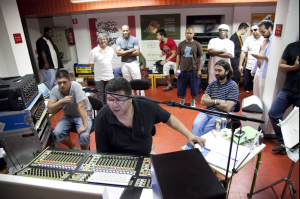
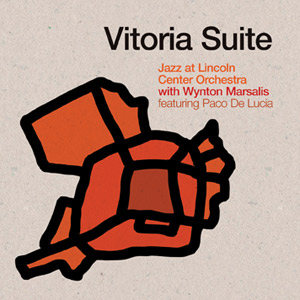
Larry Villella
January 6, 2011 at 6:06 pm (13 years ago)I understand the Soloist in Wynton’s ensemble have been touring
with the new 3 Zigma Modular Microphones. Wondering if they
were used on the Jeff Jones recordings ?
Jedi Master
January 6, 2011 at 7:38 pm (13 years ago)No actually .. Hi Larry… I think your mics are wonderful. I believe this recording was done prior to David Robinson getting those mics. I have spoken with David about geting more of those mics. Please contact me directly thejedimaster@mac.com. Those mics were used on the new record I am mixing which was recorded in Havana. I am interested in complimenting Davids mics (which I believe he is testing from you?) with additional mics which I want to either test or purchase directly. We need to get more matching mics in the upcoming recordings because the instrument section work suffers when the players balance an tonality isnt represented by matching mics. A taste of live from in Havana –
files.me.com/thejedimaster/9pb6we.mp3
READY TO PURCHASE THOSE BABYS!!
HIT ME BRO!
Jedi
John S Mcclure
January 8, 2011 at 12:24 am (13 years ago)An amazing recording of an amazing group.
JC
January 13, 2011 at 11:38 pm (13 years ago)Kudos on the piece! Jeff Jones is an excellent mixer with real vision.